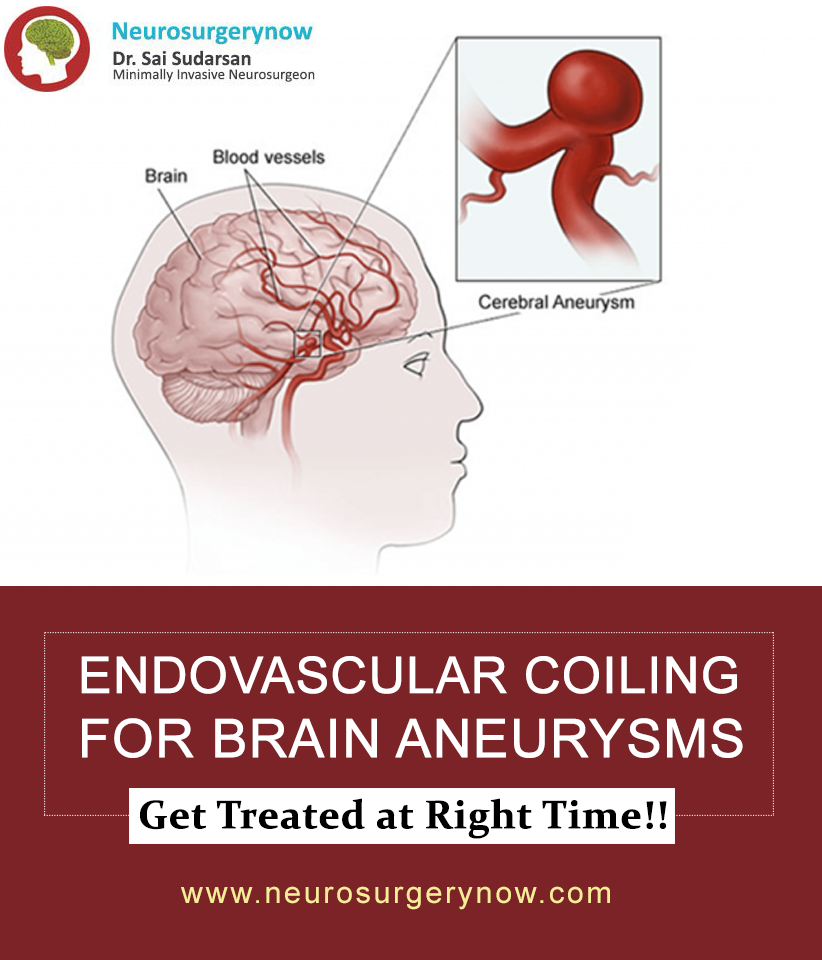A brain aneurysm (also called an intracranial aneurysm or cerebral aneurysm) is an abnormal focal dilation of an artery in the brain which causes "blister-like" dilation - widening, ballooning or bleb of a portion of a weakened blood vessel in the brain.
The larger the bulge, the more likely the brain aneurysm will bleed into and around the brain called a subarachnoid hemorrhage (SAH). When brain aneurysms bleed, they often cause stroke, coma and/or death. Strokes caused by brain aneurysm bleeds can seriously impair speech, motor and sensory function.
This occurs more frequently occurs in an artery located in the front part of the brain that supplies oxygen-rich blood to the brain tissue. However, arteries anywhere in the brain can develop aneurysms. Males have higher prevalence of aneurysms than females. They are most prevalent between 40-60 years of age and about 40% of the ruptures are fatal- a great number of disability adjusted life years are lost. The annual incidence of aneurysmal subarachnoid hemorrhage between 6 -16/100,000 populations, about 76,000-200,000 new cases occur in India each year

Types of aneurysms:
Brain aneurysms are all different. They vary in shape, size and location.
Size
- Small aneurysms - less than 5 mm (1/4 inch).
- Medium aneurysms - 6–15 mm (1/4 to 3/4 inch).
- Large aneurysms - 16–25 mm (3/4 to 1 1/4 inch).
- Giant aneurysms - larger than 25 mm (1 1/4 inch).
Shape
Aneurysms can be:
- Saccular (sac-like) - Also known as berry” aneurysm with a well-defined neck. most common type of Brain aneurysm and account for 80%- 90%
- Saccular with a wide neck
- Fusiform- (spindle shaped when viewed externally) without a distinct neck
What is the treatment for cerebral aneurysm?
The neurosurgeon or an interventional neuroradiologist will consider a variety of factors when determining the best option for treating an aneurysm, including:
- type, size, and location of the aneurysm
- risk of rupture
- the person’s age and health
- neurological condition of patient
- risk of treatment
There are two essential surgical treatments for a cerebral aneurysm:
Open craniotomy (surgical clipping): This procedure requires open brain surgery and involves cutting off the flow of blood to the aneurysm. The doctor exposes the aneurysm and places a tiny, metal, clothespin-like clip on the aneurysm’s neck to prevent blood flow into the aneurysm sac. When the clipping is finished, the skull is secured back together.
Endovascular coiling or coil embolization:
Endovascular procedures for treating aneurysms date back to the 1970s with the introduction of proximal balloon occlusion by Fjodor A. Serbinenko, a Russian neurosurgeon. Guido Guglielmi, an American-based neuroradiologist invented the platinum detachable microcoil, which was used first in 1991.

Endovascular coiling (meaning within the blood vessel) embolization (or coiling) uses the natural access to the brain through the bloodstream to diagnosis and treat brain aneurysms. The objective of this surgical treatment is to safely close off the aneurysm without blocking off any small arteries nearby or narrowing the main vessel and prevent further blood from entering into the aneurysm. With the advent of this type of treatment, some patients who previously may have been told they had inoperable aneurysms are now been provided with an alternative and a chance for treatment.
This is a minimally invasive technique, which means an incision in the skull is not required to treat the cerebral aneurysm. Rather, a steerable catheter is advanced from the femoral artery in the the groin up into the blood vessels in the brain by injecting a special dye that makes them visible on the monitor. Fluoroscopy (live X-ray) will be used to guide the catheter to the aneurysm's location in the brain.
Once the flexible catheter is in place, very tiny platinum coils (Guglielmi detachable coils, known as GDCs) are advanced through the catheter into the aneurysm. These tiny, soft, shaped like a spring platinum coils-ranging in size from about twice the width of a human hair (largest) to less than one hair's width (smallest). The coils are detectable on X-ray and conform to the shape of the aneurysm.
When the catheter has reached the aneurysm and has been inserted into the aneurysm, an electrical current is used to separate the coil from the catheter. As a result of this electrolysis, the coil detaches and it is left in place permanently in the aneurysm which seals off the opening of the aneurysm. Coils carry out from the inside what a surgical clip would accomplish from the outside. More than one coil may be required to obliterate the aneurysm depending on the size of the aneurysm. The coiled aneurysm becomes clotted off (embolization), effectively removing the risk of aneurysm rupture. This procedure is performed either under local or general anesthesia.
Dr. Sai Sudarsan is a Neurosurgeon and Neurospine Surgeon in Hyderabad and has an experience of over 3 decades in his field. He is a senior consultant in neurosurgery at Star Hospitals in Banjara Hills, Hyderabad. His fields of expertise are micro neurosurgery, neuroendoscopy, Spine Surgery, Epilepsy surgery, Peripheral Neuro surgery, Endovascular Treatment India, Microvascular spinal instrumentation, Brain Aneurysm Treatment, stereotaxy etc He also got trained in endovascular neurosurgery and considered as one of the best for Aneurysm Surgery Hyderabad. He is a pioneer in neurology and neurosurgery with a wealth of experience in handling different neurological cases successfully, over the years and is also one of the most acclaimed names in Endovascular Treatment India.

Mail us : This email address is being protected from spambots. You need JavaScript enabled to view it.
Book an appointment : www.neurosurgerynow.com/book-appointment.html


